Tempers Rising
As time went by in die 1600’s, illegal trade with the Khoikhoi became a popular way of making a few extra guilders for the Free Burghers, despite the strict Dutch East India Company or VOC - Vereenigde Landsche Ge-Oktroyeerde Oostindische Compagnie - prohibition on fraternising with the locals.

To make matters worse, many of these ‘trading’ parties were actually lightly veiled cattle raids, and the Khoikhoi forbearance of the Europeans began to wear thinner and thinner. Tempers were rising right across the Cape, and the whole region was becoming 'vrot' rotten with tension. Worst of all, for the Company, it was becoming clear that their great agricultural experiment had failed.
Ten years had passed since the first farmers started erecting their huts along the Liesbeek River, and the Company men at the Castle were still eating rice imported from Batavia. Food production was low, the natives were on the verge of revolt, and the costs of running the Cape were mounting.
An Unwitting Colony
Ironically, by this time, the Dutch East India Company was in too deep. It couldn’t change the current dispensation without causing major ructions with the Free Burghers and, despite tough working conditions and low profit margins, the inexorable movement of agricultural farmers across the land continued.
So, as they finished their contracts, more and more Company employees were choosing to remain at the Cape and take up the offer of free land. Even immigrants from Europe were coming to the Cape to avail themselves of the Company’s uncharacteristic largesse. Farms were subsequently declared further and further afield, and all the Company’s attempts to contain their presence at the Cape could not stop the farmers from extending the frontiers of the Company’s authority every year. The tiny village around the Fort thus became the capital of an unwitting colony.
European Expansion
This initial expansion of European intent, however humble, caused a ripple of concern through the local tribes, and they were right to be afraid. Over the next 150 years, the white farmers spread out to the North, and along the South-East coast, taking over vast chunks of land without so much as a by-your-leave from the local tribes.
Many of these farmers were not even interested in planting crops. They were quite happy to roam around like the nomadic bushmen, living in semi-permanent huts while raising and grazing their herds. But, as increasing numbers of cattle started competing for limited grazing pastures, the pressure on the land started to mount. Clashes with the native tribes became inevitable and, indirectly, we are still living with the consequences of this conflict today.
A Dominating Force
Khoikhoi were reeling. From a little Fort, the Dutch colony had grown into a domineering force. Colonists raided local cattle kraals with impunity, and retaliatory attacks by the Khoikhoi on the European farms were revenged by ruthless Dutch commandos. Caught between the white Devil and the deep, blue sea, the indigenous Khoikhoi community was split into those who wanted to fight, and those who chose to join the enemy.
The Dutch East India Company or VOC - Vereenigde Landsche Ge-Oktroyeerde Oostindische Compagnie, for their part, did not want a war with the Hottentots. Wars were expensive and messy. So, the Company tried to keep everyone in line, including the boisterous settlers. This was an impossible task since the settlers were already resisting the Dutch East India Company’s authority and, as far as the Khoikhoi were concerned, the Company had no right to tell the Khoikhoi chiefs what to do.
Always keen to observe the letter of the law, however, the VOC made several attempts to legitimise their tenancy of the Cape. Obviously, the Khoikhoi were unmoved until, finally, in 1672, after three major armed conflicts, the victorious VOC got the Khoikhoi to comply with a ceremony of purchase, and formally bought the Cape from the Khoikhoi for a metaphorical box of beads and a couple of blankets. From the Company’s point of view, they were now officially in charge, and it was time to consolidate their land grab.
By David Fleminger